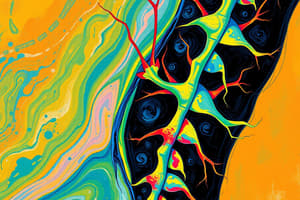Podcast
Questions and Answers
At what weeks do the brain and spinal cord begin to develop in the embryo?
At what weeks do the brain and spinal cord begin to develop in the embryo?
- Weeks 7 and 8
- Weeks 1 and 2
- Weeks 5 and 6
- Weeks 3 and 4 (correct)
What forms the brain and spinal cord during neural development?
What forms the brain and spinal cord during neural development?
- Neuronal cells
- Neural tube (correct)
- Somatic cells
- Neural crest
What are the main forms of spina bifida?
What are the main forms of spina bifida?
- Spina bifida cystica, meningocele, and occulta
- Spina bifida aperta, meningocele, and occulta
- Meningocele, syndromic spina bifida, and myelomeningocele
- Spina bifida occulta, myelomeningocele, and meningocele (correct)
What is a common complication of spina bifida?
What is a common complication of spina bifida?
What is the ductus arteriosus, and what occurs to it after birth?
What is the ductus arteriosus, and what occurs to it after birth?
What are the phases of lung development?
What are the phases of lung development?
What treatment is used for infant respiratory distress syndrome (IRDS)?
What treatment is used for infant respiratory distress syndrome (IRDS)?
What cardiovascular changes occur after birth?
What cardiovascular changes occur after birth?
Study Notes
Nervous System Development
- The brain and spinal cord begin to develop in the embryo around week 3 and 4.
- The neural tube forms the brain and spinal cord.
- The neural crest is a group of cells that develop into components of the peripheral nervous system, including spinal and cranial nerves.
- Neural tube defects, such as spina bifida, occur when the neural tube does not close properly.
Spina Bifida
- There are three main forms of spina bifida: occulta, meningocele, and myelomeningocele.
- Common complications of spina bifida include hydrocephalus, nerve development issues, paralysis, muscle weakness, and bladder dysfunction.
- Myelomeningocele, the most severe form, involves spinal fluid, meninges, and the spinal cord protruding through a vertebral defect.
Cardiogenesis
- Cardiogenesis, the development of the heart, begins in week 3 with two parallel endothelial tubes that fuse into the heart chamber.
- The ductus arteriosus is a fetal vessel connecting the pulmonary trunk to the aorta, which closes after birth to separate pulmonary and systemic circulation.
Congenital Heart Defects
- Common defects include atrial septal defect, ventricular septal defect, patent ductus arteriosus, and pulmonary stenosis.
- Congenital heart defects can be classified into four categories: lesions increasing or decreasing pulmonary blood flow, obstructive lesions, and mixed lesions.
Lung Development
- Lung development occurs in five phases: embryonic, pseudoglandular, canalicular, saccular, and alveolar.
- Surfactant, a substance that reduces surface tension, is essential for proper lung function.
- Premature births can lead to complications such as insufficient surfactant and immature lungs, resulting in infant respiratory distress syndrome (IRDS).
- Treatment for IRDS includes corticosteroids, continuous positive airway pressure (CPAP), and surfactant therapy.
Postnatal Changes
- After birth, the ductus arteriosus and foramen ovale close.
- Pulmonary circulation increases after birth.
- Newborns have elevated heart and respiratory rates to meet increased metabolic demands.
Studying That Suits You
Use AI to generate personalized quizzes and flashcards to suit your learning preferences.
Related Documents
Description
Explore the fascinating stages of nervous system and heart development in this quiz. Learn about the formation of the brain, spinal cord, and the various forms of spina bifida. Discover the critical processes of cardiogenesis that begin early in embryonic development.




